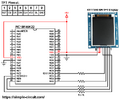DogFlu66
Member
I leave the library to use ST7789 TFT display, I have translated one that is in C language. But unfortunately I have not been able to get it to work yet. I leave the files in case someone with more experience with these displays can review it.

